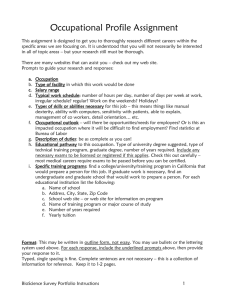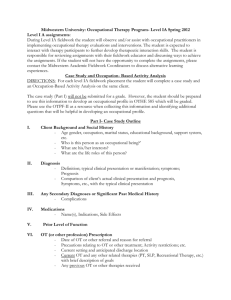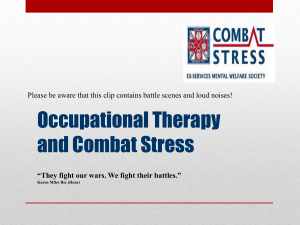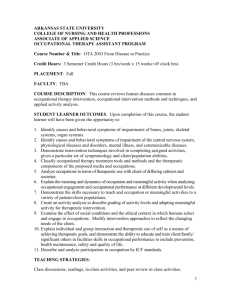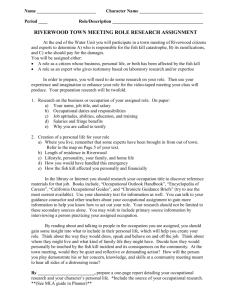4150_fall_2012
advertisement
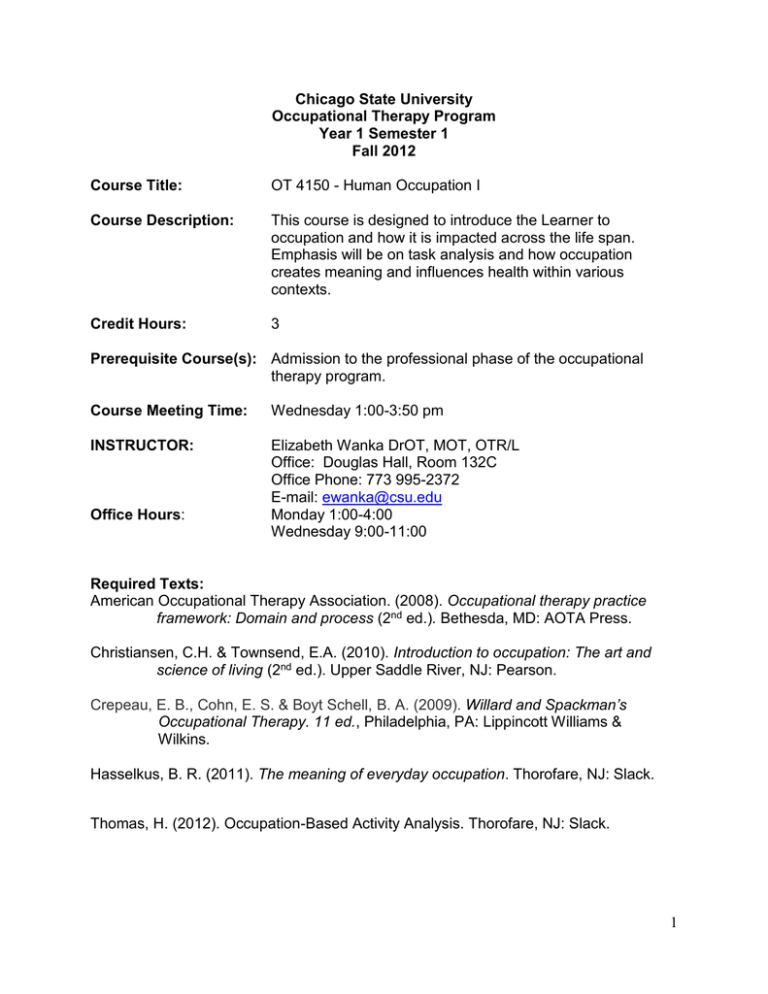
Chicago State University Occupational Therapy Program Year 1 Semester 1 Fall 2012 Course Title: OT 4150 - Human Occupation I Course Description: This course is designed to introduce the Learner to occupation and how it is impacted across the life span. Emphasis will be on task analysis and how occupation creates meaning and influences health within various contexts. Credit Hours: 3 Prerequisite Course(s): Admission to the professional phase of the occupational therapy program. Course Meeting Time: Wednesday 1:00-3:50 pm INSTRUCTOR: Elizabeth Wanka DrOT, MOT, OTR/L Office: Douglas Hall, Room 132C Office Phone: 773 995-2372 E-mail: ewanka@csu.edu Monday 1:00-4:00 Wednesday 9:00-11:00 Office Hours: Required Texts: American Occupational Therapy Association. (2008). Occupational therapy practice framework: Domain and process (2nd ed.). Bethesda, MD: AOTA Press. Christiansen, C.H. & Townsend, E.A. (2010). Introduction to occupation: The art and science of living (2nd ed.). Upper Saddle River, NJ: Pearson. Crepeau, E. B., Cohn, E. S. & Boyt Schell, B. A. (2009). Willard and Spackman’s Occupational Therapy. 11 ed., Philadelphia, PA: Lippincott Williams & Wilkins. Hasselkus, B. R. (2011). The meaning of everyday occupation. Thorofare, NJ: Slack. Thomas, H. (2012). Occupation-Based Activity Analysis. Thorofare, NJ: Slack. 1 Program Student Learning Outcomes The graduates of the Bachelor of Science in Health Sciences (Pre-Occupational Therapy) will: 1. Use theory to support reasoning and ethical decision making in determining the health needs of individuals, organizations and communities. 2. Summarize published research related to healthcare. 3. Describe the diverse health care needs of individuals and communities and the variety of systems available to address these needs. 4. Compare the influence of social, cultural, economic, political, and occupational factors on participation and health. 5. Analyze the psychological and biological factors that influence health and wellness. 6. Value interdisciplinary collaboration, service and life-long learning. Course Objectives: 1. Define roles, occupation, tasks and meaning from an occupational performance perspective (comprehension) 2. Define terminology that explains the areas, skills and contexts of occupational performance and the organization of occupations (comprehension). 3. Analyze how occupation creates unique meaning in the lives of individuals (analysis). 4. Explore the factors within an individual that influence occupational choice (knowledge). 5. Differentiate between occupation as means and ends in the OT process (comprehension). 6. Explain the dynamics of occupation including the interaction of performance patterns, performance skills, body functions and contexts (comprehension). 7. Discuss the concept of balance of occupations for life satisfaction and how occupations affect quality of life, influence health and promote a sense of well being (analysis). 8. Demonstrate the principles of grading specific occupations and apply developmental knowledge to task analysis (knowledge). 9. Demonstrate safe use and appropriate maintenance of supplies (application). 2 10. Summarize the ethical issues that support individual choice and engagement in various occupations (synthesis). 11. Analyze the demands of an activity to the situational context of individuals (analysis). 12. Compare individual perceptions of quality of life, well being and occupation to promote health and prevention of injury and disease (comprehension). 13. Analyze how social, cultural, and physical environments influence occupation and occupational choices (analysis). 14. Select occupationally based and purposeful activities that support specific therapeutic goals and that are meaningful to individuals and populations (application). 15. Demonstrate an emerging ability to differentiate between activity and occupation (application). Program Student Learning Outcomes and Course Objectives: link: This course will focus on the nature of occupation and the occupational roles across the life span along with the personal and public meaning of occupation as stated in program student learning outcomes 1-5. Learning Activities: Lecture, discussion, videotapes, group activities, role-playing, inclass activities, self-assessment, guided learning questions, demonstration, and presentation. Course Requirements: 1. ACTIVITY CONFIGURATION ASSIGNMENT: This assignment will involve each student writing a narrative paper examining the concept of balance and life satisfaction on an adult with or without a disability. Each student will be required to complete an interview with an adult of any age that examines the individual’s personal occupational patterns, occupational roles, and perceptions/feelings of balance and life satisfaction. Graduate students will include information about environmental facilitators and barriers to participation. 2. ACTIVITY ANALYSIS: Students will complete a total of three activity analysis papers. Analyses should include relevant information as outlined on the format provided by the instructor. Activity analyses should consist of activities that are developmentally appropriate and consistent with the core values of occupational therapy and the Occupational Therapy Code of Ethics. The objective of this assignment is to develop the students’ ability to use activity analysis as an evaluation and intervention tool in order to identify the component parts of activities, activity demands, and meaning attributed to activities/occupations. 3 Course Policies: 1. Attendance: Students are required to attend all classes and complete all assignments according to the course schedule. Failure to attend a minimum of 80% of all classes will potentially result in a failing grade for the course. If illness or another emergency causes a student to be absent or late, the student is responsible for contacting the course instructor before the beginning of the class session. Documentation must be submitted for excused absences. 2. Class Preparation: In order to be prepared, students must complete readings prior to the class session. Additional learning activities may be given based on class discussions that will not be graded. Students may find it helpful to cross reference ideas across multiple texts being used in the curriculum and within course. Students will be assigned specific readings but may also be referred to other texts. Exams are based on assigned reading, lectures, and presentations. 3. Class Participation: Student learning is facilitated by active class participation. Students are expected to participate actively in class discussions, and in-class activities. Students are expected to share their own ideas and applications of course concepts as well as listen to and demonstrate respect for the contributions of others. Class participation and other assignments are considered part of your professional behavior. 4. Student progress and assistance: Students are responsible for monitoring their own progress and seeking additional assistance with course material if necessary. If the students’ course grades are less than 80%, they should be seeking assistance. No extra credit is available in the course. Students are encouraged to work with peers outside of class, seek tutoring, and/or make appointments with faculty to review class assignments, review course material, or pursue course topics in more depth. 5. Accommodations: Students with disabilities who require reasonable accommodation to fully participate in this course should notify the instructor within the first two weeks of the semester. Such students must be registered with the Abilities Office of Disabled Student Services Office, SUB 198, (773) 995-4401 in order receive accommodations. 6. Assignments: All assignments are due at the beginning of the class session. Five percent (5%) of the assignment points will be deducted for each day an assignment is late. All late assignments must be date stamped and placed in 4 faculty mailbox. Zero points will be given for any assignments handed in after 7 days. Assignments must be completed for feedback. 7. Assignment Format: All assignments are to be typed, 12 point font and double spaced with 1” margins. Each page of the assignment needs to be numbered. APA format from the 6th edition of the Publication Manual of the American Psychological Association must be used in all assignments for citations and referencing. 8. Examinations: All examinations must be taken as initially scheduled. If a student misses an exam or quiz, the student may take a make up exam at the discretion of the instructor(s). A make up exam is NOT an automatic guaranteed option. 9. Withdrawal from Courses: Students must file an Add/Drop form in the Office of the Registrar before the withdrawal transaction is official. Simply ceasing to attend or notifying the instructor is not sufficient and will result in a final grade of “F”. Students will not be permitted to drop classes after the published deadline date for dropping classes. The dates of the last day to drop a course or courses are published in the University Calendar section of the Class Schedule. 10. Technology Use: Electronic devices (telephones, Bluetooth, etc.) MUST BE turned off or on a non-audible setting during class times, fieldwork, and meetings. Use of laptops and tablets in the classroom are the discretion of the individual course instructor. Students can be contacted on campus in case of emergency through the department secretary at 773-995-2366.All cell phones and pagers must be off or on silent mode during class hours. 11. Housekeeping: Student will be assigned to oversee housekeeping which includes leaving the classroom clean and in an orderly manner at the end of the session, setting up labs, putting away all lab supplies and test materials in appropriate place. Students must follow procedure for handling, maintenance, and storage of materials and supplies as outlined in the student safety manual. 12. Plagerism: Students who plagiarize from students or any other source including materials without proper referencing will be sanctioned for the assignment and may be reported to the University Judicial Board. Repeated incidences of plagiarism will result in failure of the course, probation and/or dismissal. Please review the definition of plagiarism and types of plagiarism at the following website, http://www.plagiarism.org. The specific policy on plagiarism is found in the Department of OT Student Handbook. 13. Emergency Evacuations: All emergencies occurring on campus, life threatening and non‐life threatening, should be reported to the campus police by calling ext. 2111 from any campus phone and either 911 or (773) 995‐2111 from a cell phone. Evacuate a building when the fire alarm sounds, you smell gas or smoke, see fire or is instructed to do so by staff or emergency personnel. You 5 may also receive instructions over the university’s public address system and RAVE, the emergency notification system. 14. Emergency Notification Program: If possible, assist individuals with disabilities who require assistance to egress from an upper floor or sub‐ground level floor of a building. Once an evacuation has been mandated, all evacuees should meet at a designated location where attendance must be taken. If anyone is missing, emergency personnel must be informed immediately. Visit www.getrave.com/login/csu for additional information. Grading Criteria: Grading Scale: Activity Analysis – 3@15% each 45% Activity Configuration 15% Midterm 20% Final _20% 100% A = 90 – 100 B = 80 – 89 C = 79 – 75 D = 74 - 70 F = 69 and below F = Academic Dishonesty Objectives 1,2,3,4,6,7,8,11,13 3,4,6,7,9,12,13, 15 1,2,5,7,11,13, 15 1,2,5,7,9-11,13,14, References: Case-Smith, J., & O'Brien, J. C. (2009). Occupational Therapy for Children (Vol. 6th ). St Louis, MO. , USA: Mosby Inc. Crepeau, E. B., Cohn, E. S. & Boyt Schell, B. A. (2009). Willard and Spackman’s occupational therapy (11th ed.) Philadelphia, PA: Lippincott Williams & Wilkins Gray, J. M. (1998). Putting occupation into practice: Occupational as ends, occupation as means. American Journal of Occupational Therapy, 53, 354-364. Hinojosa, J. & Blount, M. (2004). The texture of life: Purposeful activities in occupational therapy (2nd ed.) Bethesda, MD: American Occupational Therapy Association. Llorens, L.A. (1991). Performance tasks and roles throughout the life span. In C. Christiansen & C. Baum (Eds.), Occupational therapy: Overcoming human performance deficits. Thorofare, NJ: Slack, Inc. Pierce, D.E. (2003). Occupation by design: Building therapeutic power. Philadelphia, PA: F.A. Davis. Watson, D.E. & Wilson, S.A. (2003). Task analysis: Individual and population approach (2nd ed.) Bethesda, MD: American Occupational Therapy Association. 6

